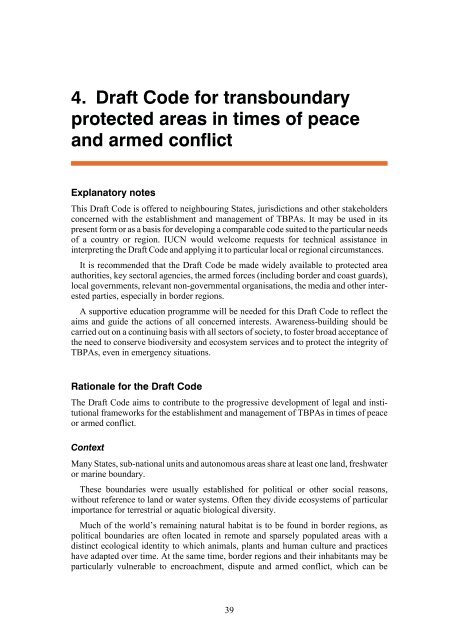Transboundary Protected Areas for Peace and Co-operation - IUCN
Transboundary Protected Areas for Peace and Co-operation - IUCN
Transboundary Protected Areas for Peace and Co-operation - IUCN
You also want an ePaper? Increase the reach of your titles
YUMPU automatically turns print PDFs into web optimized ePapers that Google loves.
4. Draft <strong>Co</strong>de <strong>for</strong> transboundary<br />
protected areas in times of peace<br />
<strong>and</strong> armed conflict<br />
Explanatory notes<br />
This Draft <strong>Co</strong>de is offered to neighbouring States, jurisdictions <strong>and</strong> other stakeholders<br />
concerned with the establishment <strong>and</strong> management of TBPAs. It may be used in its<br />
present <strong>for</strong>m or as a basis <strong>for</strong> developing a comparable code suited to the particular needs<br />
of a country or region. <strong>IUCN</strong> would welcome requests <strong>for</strong> technical assistance in<br />
interpreting the Draft <strong>Co</strong>de <strong>and</strong> applying it to particular local or regional circumstances.<br />
It is recommended that the Draft <strong>Co</strong>de be made widely available to protected area<br />
authorities, key sectoral agencies, the armed <strong>for</strong>ces (including border <strong>and</strong> coast guards),<br />
local governments, relevant non-governmental organisations, the media <strong>and</strong> other interested<br />
parties, especially in border regions.<br />
A supportive education programme will be needed <strong>for</strong> this Draft <strong>Co</strong>de to reflect the<br />
aims <strong>and</strong> guide the actions of all concerned interests. Awareness-building should be<br />
carried out on a continuing basis with all sectors of society, to foster broad acceptance of<br />
the need to conserve biodiversity <strong>and</strong> ecosystem services <strong>and</strong> to protect the integrity of<br />
TBPAs, even in emergency situations.<br />
Rationale <strong>for</strong> the Draft <strong>Co</strong>de<br />
The Draft <strong>Co</strong>de aims to contribute to the progressive development of legal <strong>and</strong> institutional<br />
frameworks <strong>for</strong> the establishment <strong>and</strong> management of TBPAs in times of peace<br />
or armed conflict.<br />
<strong>Co</strong>ntext<br />
Many States, sub-national units <strong>and</strong> autonomous areas share at least one l<strong>and</strong>, freshwater<br />
or marine boundary.<br />
These boundaries were usually established <strong>for</strong> political or other social reasons,<br />
without reference to l<strong>and</strong> or water systems. Often they divide ecosystems of particular<br />
importance <strong>for</strong> terrestrial or aquatic biological diversity.<br />
Much of the world’s remaining natural habitat is to be found in border regions, as<br />
political boundaries are often located in remote <strong>and</strong> sparsely populated areas with a<br />
distinct ecological identity to which animals, plants <strong>and</strong> human culture <strong>and</strong> practices<br />
have adapted over time. At the same time, border regions <strong>and</strong> their inhabitants may be<br />
particularly vulnerable to encroachment, dispute <strong>and</strong> armed conflict, which can be<br />
39

















